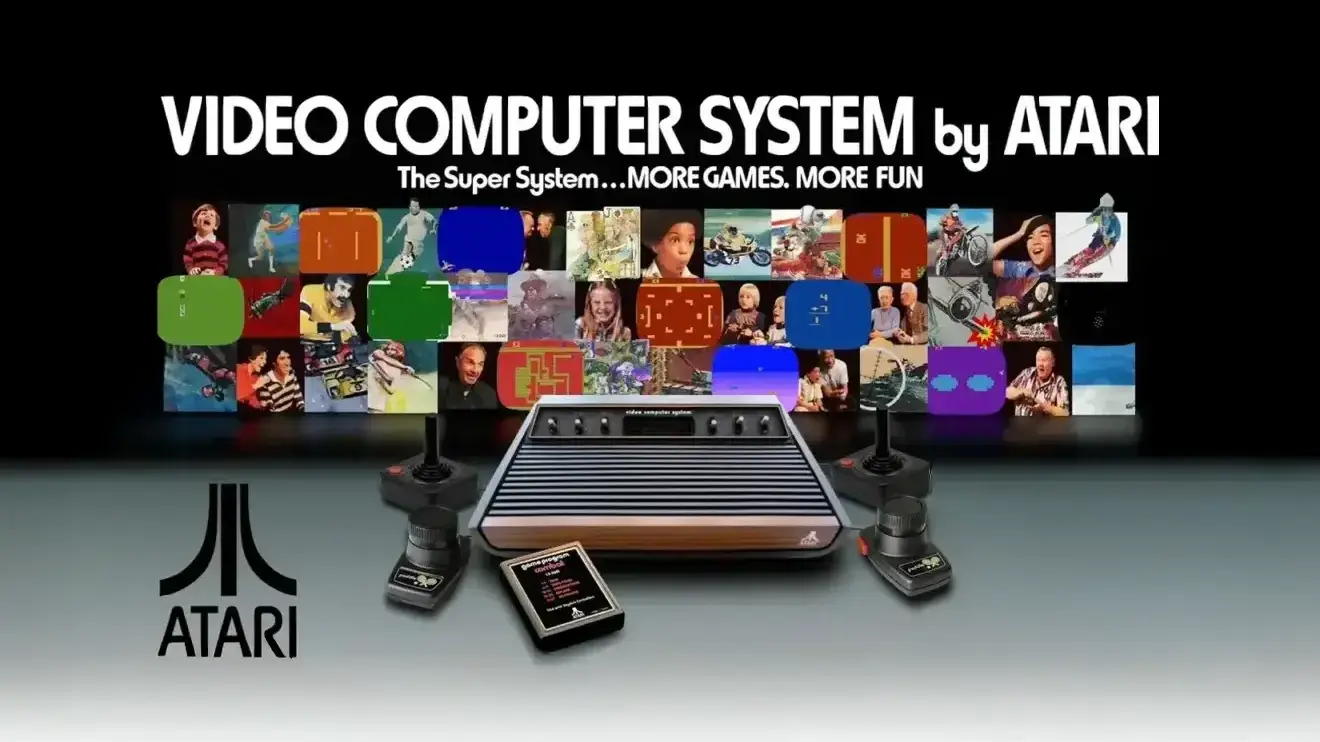Evaluating retro game console controllers involves more than just looking at connectivity, compatibility, and durability. It seeks to enrich the gaming experience by combining elements of nostalgia, comfort, price, and gameplay accuracy — qualities that modern controllers often attempt to replicate.
Define a Retro Game Console Controller
A Retro Game Console Controller is an input device designed to interact with classic video game consoles released from the late 1970s to 1999, allowing players to control gameplay actions. These controllers often feature traditional designs such as wired connectivity, D-pads, analog sticks, and simple button layouts, reflecting the technology of their time. Here are some classic video game console controllers:
- Atari 2600: A 8-bit home video game console launched in 1977 by Atari. It is wire-connected with one plain black, rubber-capped joystick mounted on a square black base, which features a large orange button located on the top right of the base.
- Famicom (FC): A 8-bit home video game console launched in 1983 by Nintendo. It is wire-connected with two red-and-gold, rectangular joypads featuring an innovative cross-shaped bulging directional pad (D-pad) for movement. Both joypads have two round action buttons. The player one joypad includes one select button and one start button, while the player two joypad has a built-in microphone that allows for voice control in certain games.
- Nintendo Entertainment System (NES): A 8-bit home video game console launched in 1985 by Nintendo. It is wire-connected with two grey-and-black, rectangular joypads featuring an innovative cross-shaped bulging directional pad (D-pad) for movement. Both joypads have two round action buttons, one select button, and one start button. The controllers use a plugable connector that fits into the console’s controller ports.
- Sega Master System: A 8-bit home video game console launched in 1986 by Sega. It is wire-connected with two black and dark grey, rectangular joypads featuring a flat square-shaped directional pad (D-pad) for movement. Both joypads have two round action buttons. The controllers use a plugable connector that fits into the console’s controller ports.
- PC-Engine: A 8-bit home video game console launched in 1987 by NEC. It is wire-connected with one grey-and-white, rounded rectangular joypad featuring a more rounded cross-shaped bulging directional pad (D-pad) for movement. The joypad has two round action buttons, one select button, and one run button. Pressing both the select and run buttons resets the game. The controller uses a plugable connector that fits into the console’s controller port.
- TurboGrafx-16: A 8-bit home video game console launched in 1989 by NEC. It is wire-connected with one grey-and-black, rounded rectangular joypad featuring a more rounded cross-shaped bulging directional pad (D-pad) for movement. The joypad has two round action buttons, turbo switches above them, and one select button and one run button. Pressing both the select and run buttons resets the game. The controller uses a plugable connector that fits into the console’s controller port.
- Sega Genesis: A 16-bit home video game console launched in 1989 by Sega. It is wire-connected with two plain black, rectangular curved joypads featuring a more rounded cross-shaped bulging directional pad (D-pad) for movement. Both joypads have three round action buttons and one start button. The controllers use a plugable connector that fits into the console’s controller ports.
- Super Nintendo Entertainment System (SNES): A 16-bit home video game console launched in 1991 by Nintendo. It is wire-connected with two light grey, rounded rectangular joypads featuring a cross-shaped bulging directional pad (D-pad) for movement. Both joypads have four round action buttons, one select button, and one start button, and two shoulder buttons. The controllers use a plugable connector that fits into the console’s controller ports.
- Neo Geo: A 24-bit home video game console launched in 1991 by SNK. It is wire-connected with two plain black, large rectangular joysticks that gives the players the feel of an arcade stick, featuring a ball-top stick for movement. Both joysticks have four round action buttons, one select button, and one start button. The controllers use a plugable connector that fits into the console’s controller ports.
- 3DO: A 24-bit home video game console launched in 1993 by Panasonic. It is wire-connected with one dark grey, blocky rectangular joypad featuring a more rounded cross-shaped bulging directional pad (D-pad) for movement. The joypad has three round action buttons, one stop button, one play button, and two shoulder buttons. A built-in headphone jack is included for private listening. The controller uses a plugable connector that fits into the console’s controller port
- Atari Jaguar: A 32-bit home video game console launched in 1993 by Atari. It is wire-connected with one plain black, bulky rounded rectangular joypad featuring a more rounded cross-shaped bulging directional pad (D-pad) for movement. The joypad has three round action buttons, one stop button, one play button, and two shoulder buttons. A built-in numeric keypad is included for specific games requiring more complex controls. The controller uses a plugable connector that fits into the console’s controller port.
- PlayStation: A 32-bit home video game console launched in 1994 by Sony. It is wire-connected two light grey, rounded rectangular joypads featuring two extended grips and a split cross-shaped bulging directional pad (D-pad) for movement. The joypads have four round action buttons, one select button, one start button, and four shoulder buttons. The controllers use a plugable connector that fits into the console’s controller ports.
- Nintendo 64 (N64): A 64-bit home video game console launched in 1996 by Nintendo. It is wire-connected four light grey, “M” shape joypads featuring three handles and a cross-shaped bulging directional pad (D-pad) for movement. The joypads have six round action buttons, one revolutionary pressure-sensitive button, one start button, and two shoulder buttons. An innovative analog stick is included for precise 360-degree movement. The controllers use a plugable connector that fits into the console’s controller ports.
- Dreamcast: A 64-bit home video game console launched in 1999 by Sega. It is wire-connected four light grey, large rounded joypads featuring two handles and a cross-shaped bulging directional pad (D-pad) for movement. The joypads have four round action buttons, one start button, two shoulder buttons, and an analog stick. An innovative Visual Memory Unit (VMU) slot with its own screen is included for additional memory, allowing for saving games and displaying game data. The controllers use a plugable connector that fits into the console’s controller ports.
Types of Retro Game Console Controllers
- Joystick Controllers: A popular input device frequently utilized in video games, especially those that aim to emulate the control layouts of arcade machines. Examples: Atari 2600 Joystick, NES Advantage Controller Joystick, Neo Geo Joystick
- Paddle Controllers: A specific kind of input device mainly utilized for video games that need one-dimensional control, like shifting an object horizontally on the display. Examples: Atari 2600 Paddle Controller, Atari 2600 Paddle Controller, Atari Super Pong, Taito FC Arkanoid Controller
- Trackball Controllers: A game controller designed with a rotating ball set in a fixed base enables players to manipulate game characters or cursors with precision, particularly in games that require accurate control and navigation. Examples: Arcade
- Joypad Controllers: Also commonly referred to as gamepads, a type of input devices designed for controlling video games on a variety of platforms, such as game consoles, handheld gadgets, and PCs. Unlike traditional joysticks, paddles, or trackballs, joypads use directional pads (D-pads) and multiple action buttons to provide players precise and responsive control for a wide range of gaming experiences. Examples: NES Joypad, TG-16 TurboPad Joypad, Sega Genesis Joypad, SNES Joypad, PlayStation Joypad
- 3D Gaming Controllers: A newer type of controllers designed with analog sticks that can detect the degree to which they are tilted, allowing for a much wider range of movement and more precise control, especially for 3D environments in games. For a more immersive and realistic gaming experience, some controllers feature vibration feedback. Examples: N64 Controller, Playstation DualShock Controller, Sega Dreamcast Controller
- Light Gun Controllers: A type of input devices designed for shooting games and utilizes light-sensing technology to detect the player’s aim on the screen. Examples: NES Zapper, SNES Super Scope, Sega Genesis Menacer Light Gun, PlayStation Justifier Light Gun
- Specialty and Experimental Controllers: A type of input devices designed for particular game genres or unique interaction styles, often varying from the standard offerings in a console’s game library. Examples: NES Power Glove, NES Power Pad, SNES Mouse & Mousepad, PlayStation Dance Pad, Sega Saturn Racing Wheel
What Makes a Good Retro Game Console Controller?
Retro-style game controllers have become increasingly popular for modern gaming systems. They offer an authentic gameplay experience, especially when playing retro games or modern remakes that were originally designed for these controllers. The unique input methods of classic controllers can provide a feel that modern alternatives often can’t replicate. This appeal is driven by a mix of nostalgia, comfort, game compatibility, and personal preference. For many players, it’s a way to reconnect with their gaming roots while enjoying the benefits of modern technology. For a truly authentic classic gaming experience, a quality retro game console controller is essential.
- Aesthetics and Nostalgia: Classic aesthetics play a significant role in their attraction. Many retro gamers favor controllers that mimic the original ones from their beloved consoles. The genuine colors, logos, and designs of retro game controllers from that time can trigger feelings of nostalgia. The tactile sensation also adds to the charm. High-quality replicas or adapters frequently become popular choices for contemporary setups.
- Accuracy and Responsiveness: A highly responsive and precise directional pad (D-pad) or joystick is crucial for games that demand exact movements, ensuring clear directional commands without any unintended diagonal inputs. An excellent D-pad enables flawless pixel-perfect platforming and executing intricate moves in fighting games. Additionally, it features minimal input lag, allowing for swift reactions in high-speed gaming scenarios.
- Control Layout: Buttons and directional controls should be easy to use for the games they are designed for. The straightforward design of classic game controllers was groundbreaking, emphasizing user-friendliness. Older games needed fewer buttons, but having more can help with modern retro games or their adaptations. For example, the six-button controller was created for fighting games. It’s important for the buttons to be sensitive enough while also being spaced out to prevent unintentional presses.
- Comfort and Ergonomics: The controller must provide a comfortable experience for players, especially during extended gaming sessions. It should strike the right balance in weight, neither being too heavy nor too light, to ensure effortless handling. A solid grip is crucial to avoid hand fatigue. Features like contoured grips, textured surfaces, and well-placed curves enhance grip quality. Additionally, buttons, D-pads, and analog sticks should be easily accessible, minimizing the need for excessive finger movement.
- Build Quality and Durability: The controller must be crafted from robust materials capable of enduring frequent use, ensuring it is well-built and feels substantial, free from any loose components, stickiness, or rattling noises. Reinforced joints and strong seams are essential to prevent cracking and to endure minor falls. Sturdy coatings should be applied to resist scratches, fading, and discoloration caused by sweat and extended handling. Additionally, the D-pads and buttons need to retain their responsiveness over time, avoiding any issues with sticking or becoming overly soft.
- Compatibility and Versatility: The retro game controller should demonstrate both proficiency with its intended titles and broader compatibility across platforms. Backward compatibility, encompassing original hardware, modern emulation software, and dedicated retro consoles, is of considerable importance. A versatile button configuration further enhances adaptability. The connection type employed influences compatibility with various devices. Features such as button remapping, adjustable triggers, and customizable profiles contribute to increased versatility by enabling players to tailor the controller to individual preferences and game requirements. The acquisition of a single, versatile controller can represent a more economical approach than investing in multiple platform-specific peripherals.
- Modern Enhancements: The functionality of retro game controllers is frequently enhanced by modern upgrades. With USB or Bluetooth connectivity, these controllers can easily connect to today’s devices. The addition of motion controls broadens their compatibility with games that require this type of input. Using mechanical switches in the buttons can create a more tactile feel and potentially improve responsiveness. Vibration feedback adds to the immersive experience, even in games that weren’t initially designed for it. Additionally, a small touchpad can offer extra control options, especially for games that benefit from this kind of input.
- Additional Features: Enhance your gaming experience by incorporating wireless connectivity to reduce cable mess, making it ideal for contemporary systems, PCs, and mobile devices. A turbo feature can be advantageous for specific games, enabling rapid button presses by simply holding down the button. Some controllers offer customization options, allowing players to set buttons according to their preferences. A compact OLED display could showcase vital information such as battery status, profile configurations, or even in-game statistics. Integrating gyroscopes or accelerometers can facilitate motion control in games that would benefit from it, such as platformers or racing titles, offering a fresh way to engage with classic games. Additionally, voice control functionality would let players execute simple commands for pausing, navigating menus, or activating special abilities. Built-in speakers could deliver nostalgic game sound effects, button clicks, or voice prompts during specific actions, further enriching the gaming atmosphere.
Recommendation for retro-style game controllers.
Here is a list of good retro-style game controllers at Amazon.com:
Here are some tips for buying retro-style game controllers:
- Original vs. Third-Party: Original controllers from brands like Nintendo, Sega, SNK, or Sony can be quite expensive. On the other hand, third-party alternatives usually come at a lower price, but their quality can be hit or miss.
- Where to Buy: Leading online stores like Amazon.com, or specialty gaming stores that focus on retro gaming and related accessories.
- Warranty and Support: Make sure to look into the manufacturer warranties and customer support available for some extra reassurance. Also, find controllers that have an active community for help, mods, or even spare parts.
Related Posts
The Legend of Atari 2600 VCS
The Atari 2600 VCS is a legend in gaming history—released in 1977, it revolutionized home…
How to Master Pro Brawl Stars Strategy Without Spending Money
Master pro-level Brawl Stars strategy with zero pay-to-win tactics. Learn advanced movement, team…
AI’s Game-Changing Impact on Gaming
AI powers modern gaming with smarter enemies, adaptive teammates, dynamic stories, and immersive…
SNK Neo Geo: The Most Immersive Arcade-at-Home Experience
The SNK Neo Geo AES, released in 1991, is a revolutionary legendary video game console system that…
5 Best-Loved Hi-Tech Virtual Pets
Discover the best-loved hi-tech virtual pets, where cutting-edge A.I., blockchain, and interactive…
The Beat of Culture: How Music-Driven Rhythm Games Shape Emotion and Fitness
Music games are a popular genre that combines musical precision with interactive gameplay,…





















